The shifting Dutch bock beer season
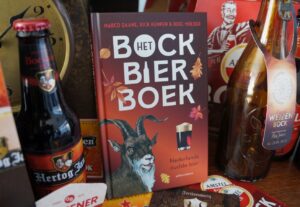 A typical beer tradition of the Netherlands: bock beer. This dark, malty and slightly sweet brew, usually about 6,5 to 7,5% ABV, is released every year in autumn. When the leaves start falling, head out through mist and rain to your bottle shop or local pub for this seasonal delight. There was a time, not long ago, that every Dutch brewer was making it, and though today the tradition is slightly obscured by all the other beer events going on in Holland (collabs, tap take-overs, barrel aged editions…), there still are lots of bock beer festivals that attract enormous crowds. That’s why a new book has hit the stores: Het Bockbierboek, ‘The Bock beer book’. In it, beer writers Marco Daane, Rick Kempen and I describe past, present and future of Dutch bock beer (in Dutch). To summarise its contents here would lead a bit far, but let’s have a look at these two questions: how old is the Dutch bock beer tradition? And was it always an autumn beer?
A typical beer tradition of the Netherlands: bock beer. This dark, malty and slightly sweet brew, usually about 6,5 to 7,5% ABV, is released every year in autumn. When the leaves start falling, head out through mist and rain to your bottle shop or local pub for this seasonal delight. There was a time, not long ago, that every Dutch brewer was making it, and though today the tradition is slightly obscured by all the other beer events going on in Holland (collabs, tap take-overs, barrel aged editions…), there still are lots of bock beer festivals that attract enormous crowds. That’s why a new book has hit the stores: Het Bockbierboek, ‘The Bock beer book’. In it, beer writers Marco Daane, Rick Kempen and I describe past, present and future of Dutch bock beer (in Dutch). To summarise its contents here would lead a bit far, but let’s have a look at these two questions: how old is the Dutch bock beer tradition? And was it always an autumn beer?
When studying the history of bock beer, you first have to wade through a large heap of legends and myths. As ‘bock’ is the German word for ‘male goat’, these myths usually involve billy goats: bock beer supposedly was named after the goats owned by the Germanic deity Donar, or after the star sign Capricorn, it supposedly was sold in inns featuring a goat on its pub sign. Another myth claims bock was named after buckwheat, or after the ‘Buckingham beer’ imported from England by duke Maximilian of Bavaria in 1623, in order to cure his wife.
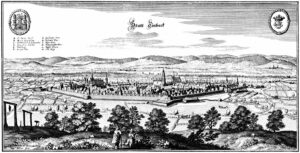 All nonsense, of course. The only consistent story is that bock beer originally hails from the German town of Einbeck in Lower Saxonia. The name ‘Einbeck’ was reinterpreted in Munich by drinkers and brewers as ‘Ein Bock’, as in ‘Can I have One Bock please?’. In any case, Munich then became the new home of bock beer in the 18th and 19th century, and it was from Munich that bock beer came to the Netherlands.
All nonsense, of course. The only consistent story is that bock beer originally hails from the German town of Einbeck in Lower Saxonia. The name ‘Einbeck’ was reinterpreted in Munich by drinkers and brewers as ‘Ein Bock’, as in ‘Can I have One Bock please?’. In any case, Munich then became the new home of bock beer in the 18th and 19th century, and it was from Munich that bock beer came to the Netherlands.
Does this mean that in Holland, every October bock beer was introduced with great fanfare, as it is now? Well, no. Oddly, in the beginning bock beer was (drum roll…) typically a spring beer. In April 1843 the ‘Munichner Bockbier’ first surfaced in Amsterdam at the Bayerisches Bierhaus (‘Bavarian beer house’) owned by one J.G.C. Friedr. Camphuynder, who would continue to import it for some twenty more years. Also in other Dutch towns bock beer was imported from Germany and introduced around the first of May, on a modest scale.
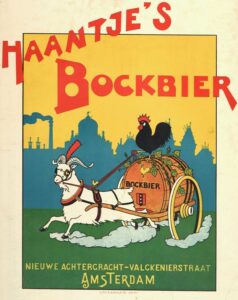 The first Dutch brewery to try and brew a bock beer itself was De Struisvogel (‘The Ostrich’) in Groningen, which advertised it in 1854 and 1857. After that, Dutch brewers remained silent on the subject for a moment, while in the mean time a revolution struck the country: the first bottom-fermenting ‘Bavarian’ breweries surfaced. Large, industrial enterprises using new brewing techniques imported from Germany, employing German personnel and making German beer styles. It was one of those companies, the Koninklijke Nederlandsche Beiersch Bierbrouwerij (‘Royal Dutch Bavarian brewery’) in Amsterdam, who released its first bock beer in March 1868. In April 1872 their example was followed by Amstel, founded two years previously, and in February 1874 by Heineken.
The first Dutch brewery to try and brew a bock beer itself was De Struisvogel (‘The Ostrich’) in Groningen, which advertised it in 1854 and 1857. After that, Dutch brewers remained silent on the subject for a moment, while in the mean time a revolution struck the country: the first bottom-fermenting ‘Bavarian’ breweries surfaced. Large, industrial enterprises using new brewing techniques imported from Germany, employing German personnel and making German beer styles. It was one of those companies, the Koninklijke Nederlandsche Beiersch Bierbrouwerij (‘Royal Dutch Bavarian brewery’) in Amsterdam, who released its first bock beer in March 1868. In April 1872 their example was followed by Amstel, founded two years previously, and in February 1874 by Heineken.
Bock was a bottom-fermented Bavarian beer type (some Dutch brewers use the Dutch spelling ‘bok’), and it were the new, Bavarian-style brewers who introduced bock to the Dutch market as a seasonal beer, as an extension of their portfolio consisting of Pilsener, Münchener, Dortmunder and Vienna. The old-fashioned top-fermenting Dutch brewers never really followed suit.
The tradition of bock as a seasonal beer consumed in spring came, of course, from Germany. From Munich, were it was the focus of a beer fest around Sacrament Day (the second Thursday after Whitsunday), but also from Berlin, where the bock season lasted for no less than two months. On Easter Monday Berliners would flock to the Bock-Brauerei on Kreuzberg, where in large halls a boisterous crowd would gulp down their ‘dark brown, syrupy bock beer featuring a yellow-white thick foam’ in glasses of one litre. These Oktoberfest-like scenes have existed up to the Second World War and even after, though the season shifted a bit, to commence in January and last until March. Today, this tradition has vanished, as far as I know.
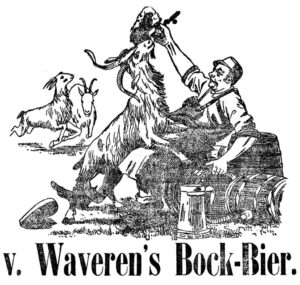 Back to the Netherlands. What about our own bock beer culture? As in Berlin, the bock season had slowly started shifting, so that by 1900 it fell in the months December to March. ‘Season’ is perhaps too big a term: at first, bock events were scarce. Only in the city of Leiden, brewer Van Waveren made a large chariot tour the town, pulled by two mighty horses, with on it a large barrel and a notification: ‘Van Waveren’s bock beer on sale tomorrow!’
Back to the Netherlands. What about our own bock beer culture? As in Berlin, the bock season had slowly started shifting, so that by 1900 it fell in the months December to March. ‘Season’ is perhaps too big a term: at first, bock events were scarce. Only in the city of Leiden, brewer Van Waveren made a large chariot tour the town, pulled by two mighty horses, with on it a large barrel and a notification: ‘Van Waveren’s bock beer on sale tomorrow!’
After the First World War Dutch brewers made an agreement on the bock season. Nationwide the first bock beer would go on sale on the second Thursday in December, and the season would last until New Year’s day or so. And look, in 1936 there was a first ‘entry parade’ for bock beer in Amsterdam, a tour through the city, with floats and several real goats. In the province of Limburg, the Brand brewery copied the idea of such a ‘joyous entry’ in the city of Maastricht. However, in 1940 the fun ended. War broke out, and because of a lack of grain the brewers announced they discontinued their bocks.
It wasn’t until 1948 that bock returned, on the 2nd of December. Which meant that the bock season remained rather short. In the 1960s, the Heineken brewery admitted during a shareholder meeting that ‘bock still was a pleasant distraction, but no longer of commercial value’. In other words, bock was still produced, but it hardly was a success.
Then, in the seventies, something strange occurred. In 1975 Heineken released its bock around 15 November, but the next year they advertised it on the 7th of October. Did they single-handedly advance the bock season by more than a month? Probably. Maybe they lengthened the season this way in order to recuperate some of the costs of their bock advertising campaigns.
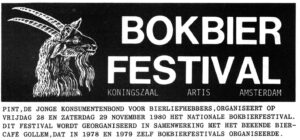 As said, by then bock took up only a tiny fragment of the Dutch beer market. Over 99% of beer produced and consumed in the Netherlands was pilsener-style lager. Bock was one of the few escape routes from this true ‘lager desert’ of uniformity. In 1978 the tiny Gollem café in Amsterdam held a bock festival, featuring no less than six different Dutch bock beers (though other sources suggest there may have been a few more). Two years later, the Amsterdam bock festival was adopted by the freshly founded Dutch beer drinker’s association PINT, and grew into a huge event that attracted thousands of visitors each year. Sadly, its last edition was in 2018, but there are still plenty of other bock festivals around in the Netherlands: the Bock Day in Zutphen on 8 October 2023, the festival in Utrecht on 13-15 October, and many more. Bock is still ‘sloshing against the skirting boards’ as they say over here.
As said, by then bock took up only a tiny fragment of the Dutch beer market. Over 99% of beer produced and consumed in the Netherlands was pilsener-style lager. Bock was one of the few escape routes from this true ‘lager desert’ of uniformity. In 1978 the tiny Gollem café in Amsterdam held a bock festival, featuring no less than six different Dutch bock beers (though other sources suggest there may have been a few more). Two years later, the Amsterdam bock festival was adopted by the freshly founded Dutch beer drinker’s association PINT, and grew into a huge event that attracted thousands of visitors each year. Sadly, its last edition was in 2018, but there are still plenty of other bock festivals around in the Netherlands: the Bock Day in Zutphen on 8 October 2023, the festival in Utrecht on 13-15 October, and many more. Bock is still ‘sloshing against the skirting boards’ as they say over here.
Want to know more? Read Het Bockbierboek and brush up your knowledge of bock and of the Dutch language.






Leave a Reply